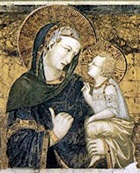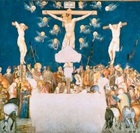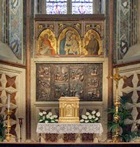
Detail of frescoed altarpiece (ca. 1315) of
the Altare di San Giovanni Evangelista
Lower Church, San Francesco, Assisi (left transept)
The brothers Pietro and Ambrogio Lorenzetti were both important artists who trained in Siena: Pietro who was probably the elder of the two, is the only one of the brothers known to have painted in Umbria (at Assisi - see below).
Very little is known about the early career of Pietro Lorenzetti. However, four documented works from the latter part of his career survive:
-
✴the so-called Tarlati Polyptych, which Bishop Guido Tarlati of Arezzo commissioned in 1320 for the high altar of the Pieve di Santa Maria, Arezzo, where it survives in situ;
-
✴an altarpiece (1329) for the Carmelites’ church in Siena, the panels of which have been dispersed;
-
✴an altarpiece (1340) of the Maestà with angels from San Francesco, Pistoia, which now in the Uffizi Gallery, Florence; and
-
✴a panel (1342) of the birth of the Virgin, the only survival from a triptych painted for the Duomo, Siena, which is now in the Museo dell’ Opera del Duomo there.
He died in Siena in 1348, presumably during the Black death.
San Francesco, Assisi
The frescoes in the left transept of the Lower Church of San Francesco were first attributed to Pietro Lorenzetti in 1864, and this attribution is now generally accepted. This work, which was undertaken in a single, continuous campaign, probably began soon after the election of Brother Michael of Cesena as Minister General in 1316 (as described in the page on San Francesco in the 14th century). The frescoes included:
-
✴scenes from the Passion of Christ (including the magnificent Crucifixion depicted here), and

-
✴a fictive chapel, complete with a fictive altarpiece of the Madonna and Child with SS Francis and John the Evangelist.


The circumstances in which work on the chapel was abandoned were probably associated with the invasion of Assisi by the Ghibelline Muzio di Francesco in 1319, aided by Bishop Guido Tarlati of Arezzo and Count Federico da Montefeltro (as described in the page on San Francesco in the 14th century). In October 1319, Muzio di Francesco forced Bishop Teobaldo Pontano and the custodian of San Francesco to hand over papal tithes that had been collected in Assisi and Nocera; and in March 1320, he stole not only the papal treasure deposited at San Francesco, but also the money that Napoleone Orsini had deposited there. Pope John XXII excommunicated Muzio di Fancesco in 1320 and fled to Todi in 1321. John XXII also placed Assisi under interdict in an effort to recoup the stolen treasure, and the city was forced to submit to Perugia in 1322. Muzio di Francesco repaid 1,000 gold florins to Napoleone Orsini in 1323, but by then the damage had been done. Napoleone Orsini died in Avignon in 1342 and seems to have been buried in the Cappella di San Marziale, in old St Peter’s, Rome.
Napoleone Orsini is known to have been sympathetic to the Ghibelline cause in Italy, and it may well be that he lost interest in Assisi only after the appropriation of his own assets in March 1320. It is probably not coincidental that his ally, Bishop Guido Tarlati commissioned Pietro Lorenzetti to paint the so-called Tarlati Polyptych (see above) in Arezzo only a month later. This work (and other panels that Pietro Lorenzetti executed in Cortona, which was part of the diocese of Arezzo) are closely linked stylistically with the Assisi frescoes, suggesting that Pietro established his reputation not in his native Siena but under the patronage of Napoleone Orsini and his Ghibelline associates.
Read more:
H. Maginnis, “Pietro Lorenzetti: a Chronology”, Art Bulletin 66 (1984) 183-211
S. Brufani, “Eresia di un Ribelle al Tempo di Giovanni XXII: II Caso di Muzio di Francesco d' Assisi”, Assisi (1982)
Return to Art in Assisi.
Return to “Foreign” Painters in Umbria.



